#Calliope Hummingbird Male
Explore tagged Tumblr posts
Text

Calliope Hummingbirds (Selasphorus calliope), male displaying to female, family Trochilidae, order Apodiformes, BC, Canada
photograph by Walter Nussbaumer
2K notes
·
View notes
Note
Top five small birds go
PICKING ONLY 5 is CRUEL but I don't have time for 10. Species names will have the links to photo sources where applicable.
Long-tailed Manakin. They take like 4-5 years for the males to learn their dances and each year they look a little more like adults to match their experience! They are little and yet have very long tails!! And cute little caps! Very elegant tiny birds.
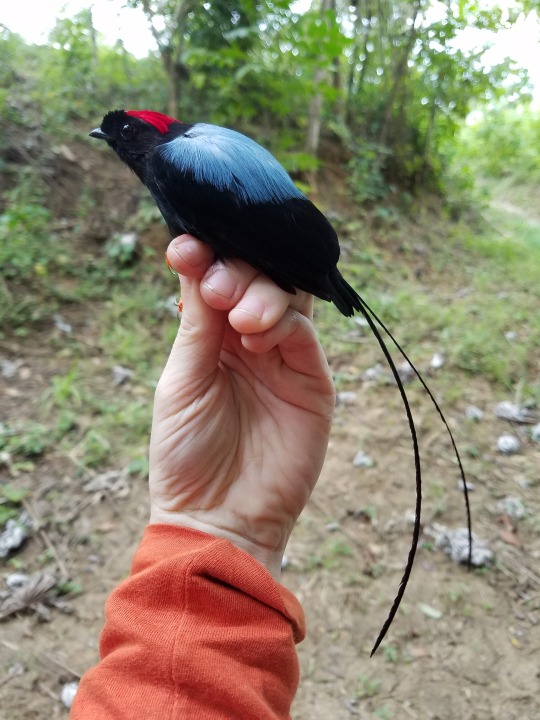
(Photo by me, bird handled and released on site with permits as part of MoSI, a long-running collaborative research program).
2. Wrentit. Look past the plain gray exterior, let me teach you some BIRD FACTS because these guys are basically aliens. They live in a very small part of the west coast of North America in scrub/chaparral, and we still don't really know how they got there or where their nearest relatives are or what birds they're even related to, though recently they think maybe it's parrotbills, which are otherwise mostly found in SE Asia.
During the breeding season, most female birds develop a brood patch, a section of bare skin on the belly for aiding in heat transfer to the eggs, and most male birds develop a swollen cloaca to facilitate sperm transfer. In some species where males help incubate, they also get brood patches. This is fine. Male Wrentits get brood patches. A little weird but not too crazy. Female Wrentits, however, get a swollen cloaca? Why?? Nothing else in North America does this? I don't.... understand.
Also they're cute, they have a song that's like a bouncy ball going down stairs, and males and females have slightly different songs, so even though we can't determine the sex in the hand like with normal birds, at least if they sing you can tell. Normal birds don't sing when being handled. Wrentits definitely sometimes do. I don't get it. But I love them for it.

(Photo mine, bird banded and released on site with permits as part of MAPS, a long-term research program).
3. Calliope Hummingbird. Itty bitty tiny creature, would absolutely spear you to death with its face if it thought it could pull that off. Hummingbirds in general are territorial and aggressive and these guys are no exception. Also they're beautiful. Look at that starburst of a face!

(I have photos but don't want to go dig them up, I'm lazy)
4. Java Sparrow. Help, I'm hopelessly charmed by how adorable they are. Unfortunately, apparently everyone else is too, and these are now critically endangered in their home range of Java due to habitat loss and poaching for the pet trade. The good?? news is they're also super invasive in places like Hawaii, so they're not about to go globally extinct, so that's cool, I guess.
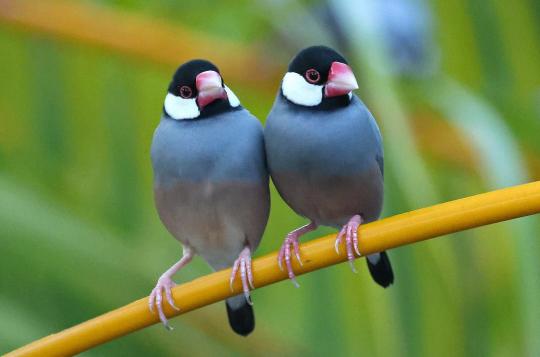
5. Micronesian Rufous Fantail, formerly just Rufous Fantail, aka chichirika na'abak because look I don't know proper indigenous names for everything but I do for my study birds and I support their use. Chichirika is CHamoru for "showoff" and na'abak is "the one who will lead you astray", after the local stories of kids trying to follow these delightful little low-flitting creatures through the jungles and getting hopelessly lost, leading to village search parties.
Anyway, look at that tail!! Go listen to their cute little squeaks! I'm absolutely in love. I've banded literal hundreds of these and they never ever get old. Every single one of them is a treasure to me.
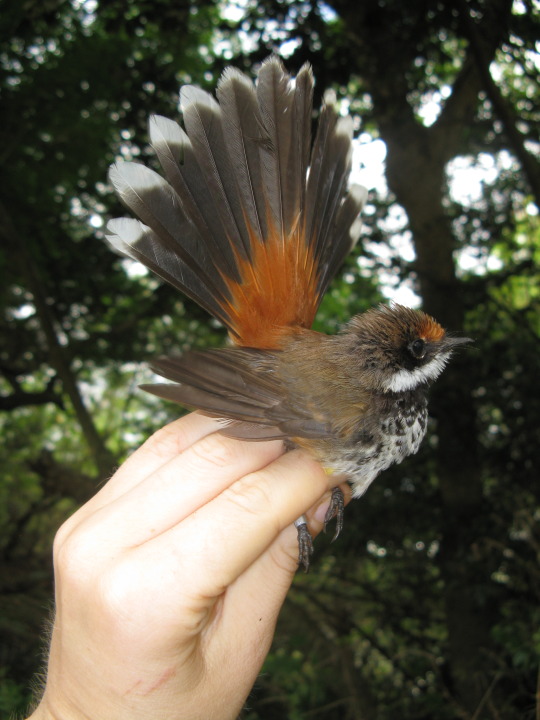
(Photo by me, bird banded and released on site as part of my very most beloved own tropical forest bird research program in the Northern Mariana Islands).
282 notes
·
View notes
Text

male Calliope hummingbird
#photography#garden#nature#wildlife#bird#animal#hummingbird#birds#original art#cute#love#adorable#artists on tumblr
53 notes
·
View notes
Text

Scout Bechtel
Male Calliope Hummingbird flaring his
gorget to try to impress the female Calliope
Columbia, Canada.
57 notes
·
View notes
Video
Male Calliope Hummingbird by Rick LeBaudour Via Flickr: Rock Creek Lodge in the Eastern Sierra
5 notes
·
View notes
Text
Closeup look of my Umbrastaff!
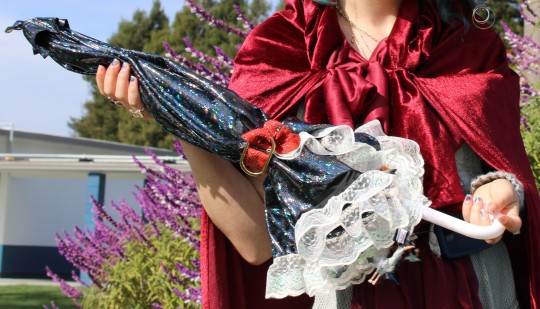
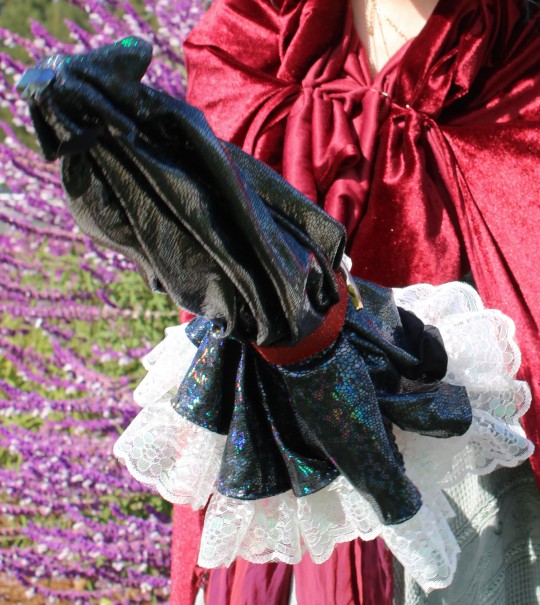

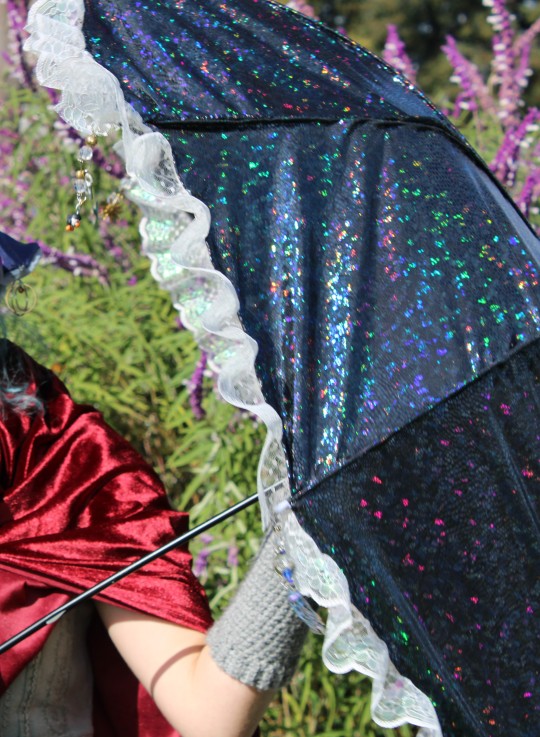

I made it myself, using a broken umbrella (that I fixed with just a lil hot glue) I found in my school's lost n found. It wasn't theft, if they wanted it back it would not have been sitting there for seven months.
I got the fabric from JoAnn's Witching Hour collection, it's stretchy and black with kind of a cobblestone pattern with an iridescent rainbow shimmer that absolutely sparkles in the light! It reminded me of The Hunger so I knew I had to get it. I hand sewed each piece on around the frame, and though it is... messy... it adds character. The lace was also from JoAnns, and it has an iridescent shimmer that immediately drew my eye. I sewed on each length after the main part of the umbrella was complete-- I thought it could use some flair :)
As for the ribbon, I actually found that at a thrift store? It has some pieces of silver tinsel(?) weaved into it. The belt loop to secure the umbrella closed I honestly just stole from one of my belts. Umbrastaff > holding my pants up
That brings me to the part I am MOST excited to share; the charms!
Each point of the umbrella (there are 8 in total) has a charm secured to it that I made. I held an eyepin over a candle (with jewelry pliers. i am not here to get burnt.) and melted it into the plastic knob at the end, then secured with superglue. Then, separately, I made each charm out of wire, which I added beads to, and looped at both ends and the middle, so that I could attach it to the umbrella and the 2 charms I prepared for each.. hangy.. thing. They each have a charm I either made or selected to represent their respective bird, which is lowermost.
The Twins
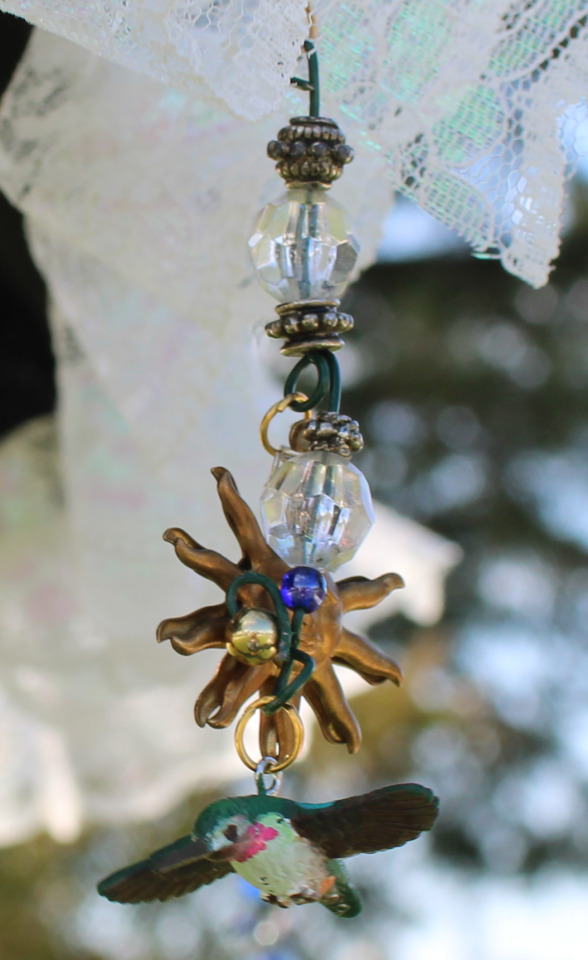

For Lup (left) and Taako (right), I wanted them to match. I bought these little hummingbirds from a cute treehouse themed bookstore on my trip to Oregon, and after adding an eyepin, painted them over to resemble a calliope hummingbird and lucifer hummingbird, respectively. I thought hummingbirds were a good representation of the twins because of their constant need to move and the energy they have. Plus, their plumage is beautiful while still blending in to their environment. Lup got a sun charm (which I got from someone who does garage sales for a living?? one of her suppliers had a bunch of broken jewelry pieces so score I guess!) and Taako got a wizard hat, which is a repainted lego piece!
The Lover

Barry's bird was perhaps the most obvious choice for me. A bluejay. Not only are they BLUE! J! but they are incredibly intelligent and have tight family bonds. This charm was made from the same material as the twins', as it was a miniature by the same company, but he actually started out as a cardinal! I may or may not have bought a 6 pack variety bag specifically to obtain him... jury's still out on that one. His charm is a flying bird since I thought it could symbolize his role as the lover, especially with his long search for Lup.
The Protector
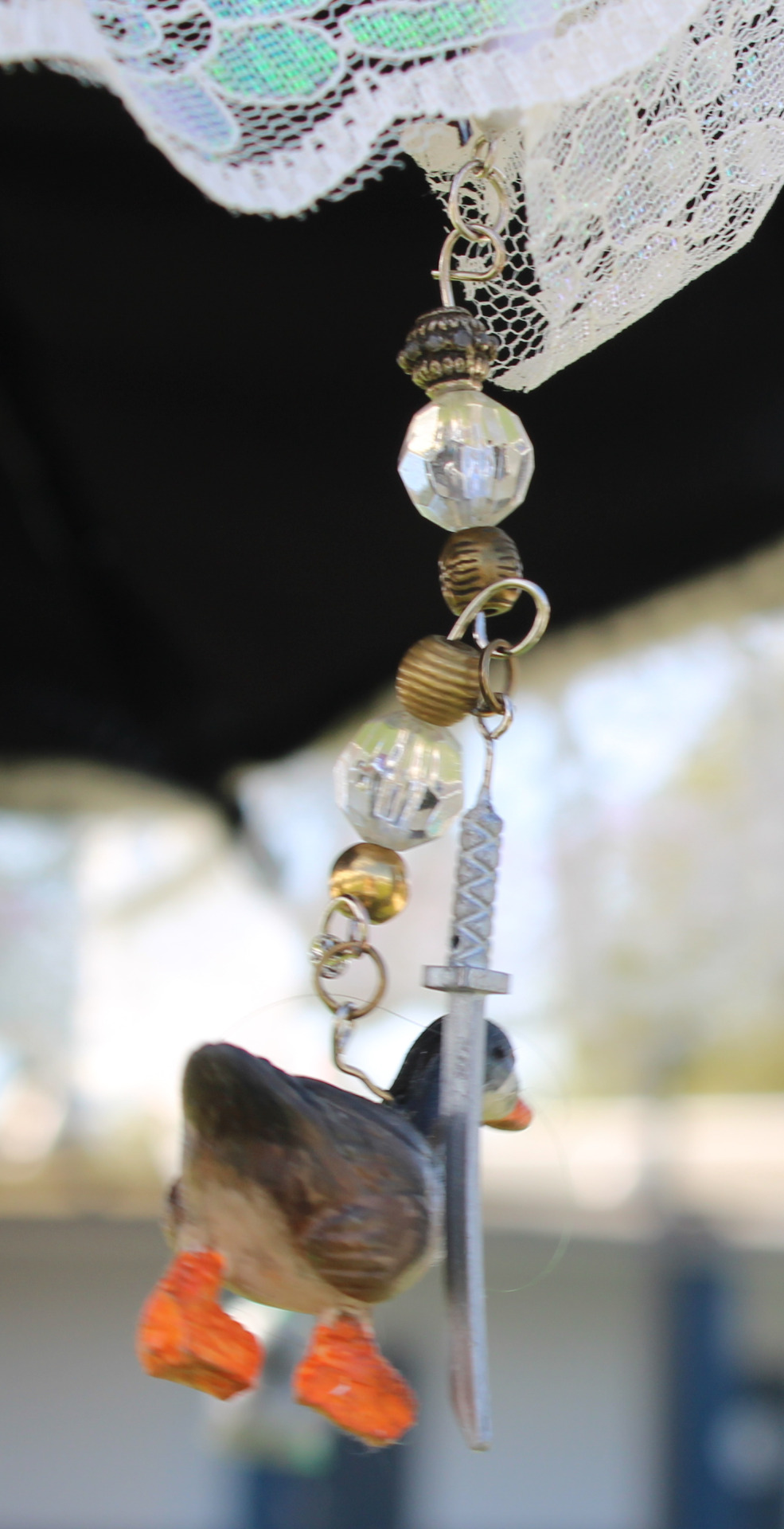
Look. I couldn't NOT make Magnus a wood duck. It's right there. This is a male wood duck's "eclipse plumage," in which they lose their bright colored feathers in favor of duller ones. I painted this a duck figure that came in a big bag of other animal toys that I bought at a thrift store specifically for my craft reserves... Good thing I did! The sword is a lego piece. My friend was heavily distracted by the fact I had a lego sword on my umbrella. Personally I found the wizard hat on my head to be more distracting but to each their own.
The Lonely Journal Keeper
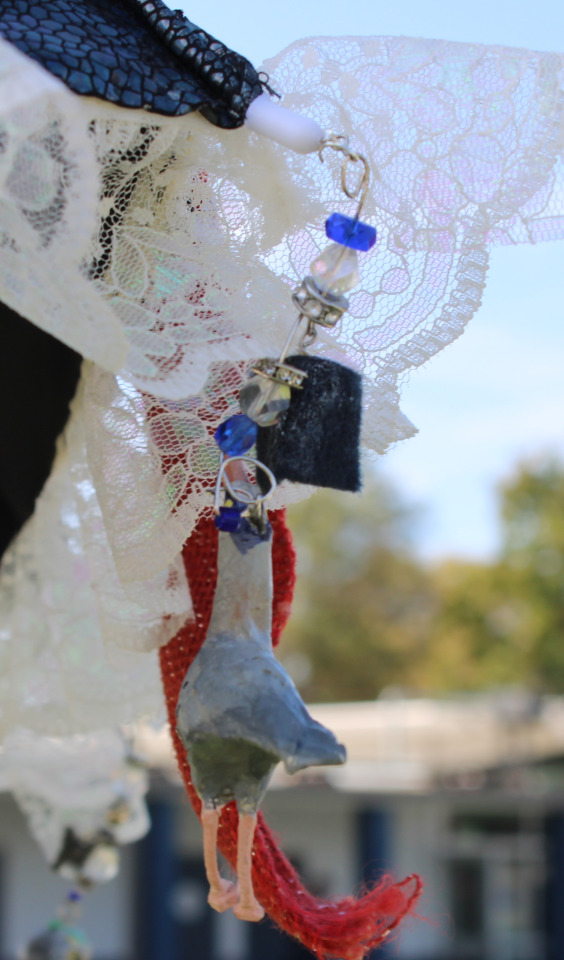
I know, not the most flattering angle. Believe it or not, this Great Blue Heron used to be an ostrich! With a little paper mache, paint, and imagination, Lucretia came to be. Coincidentally, on my trip to San Diego for the TAZ liveshow, we went to the zoo, and there was a great blue heron chilling in the penguin exhibit! I asked the zookeeper if it was theirs, but she said he just showed up same time every day (around lunch time...). The book on this charm I made from scrap felt (hat material) and paper. It was originally a lego book that I repainted, but that seems to have gotten lost when the charm fell off earlier-- some lovely folks dressed in Amnesty cosplay handed me the bird after it fell. Thank you guys for that cause I would have been devastated<3
The Peacemaker
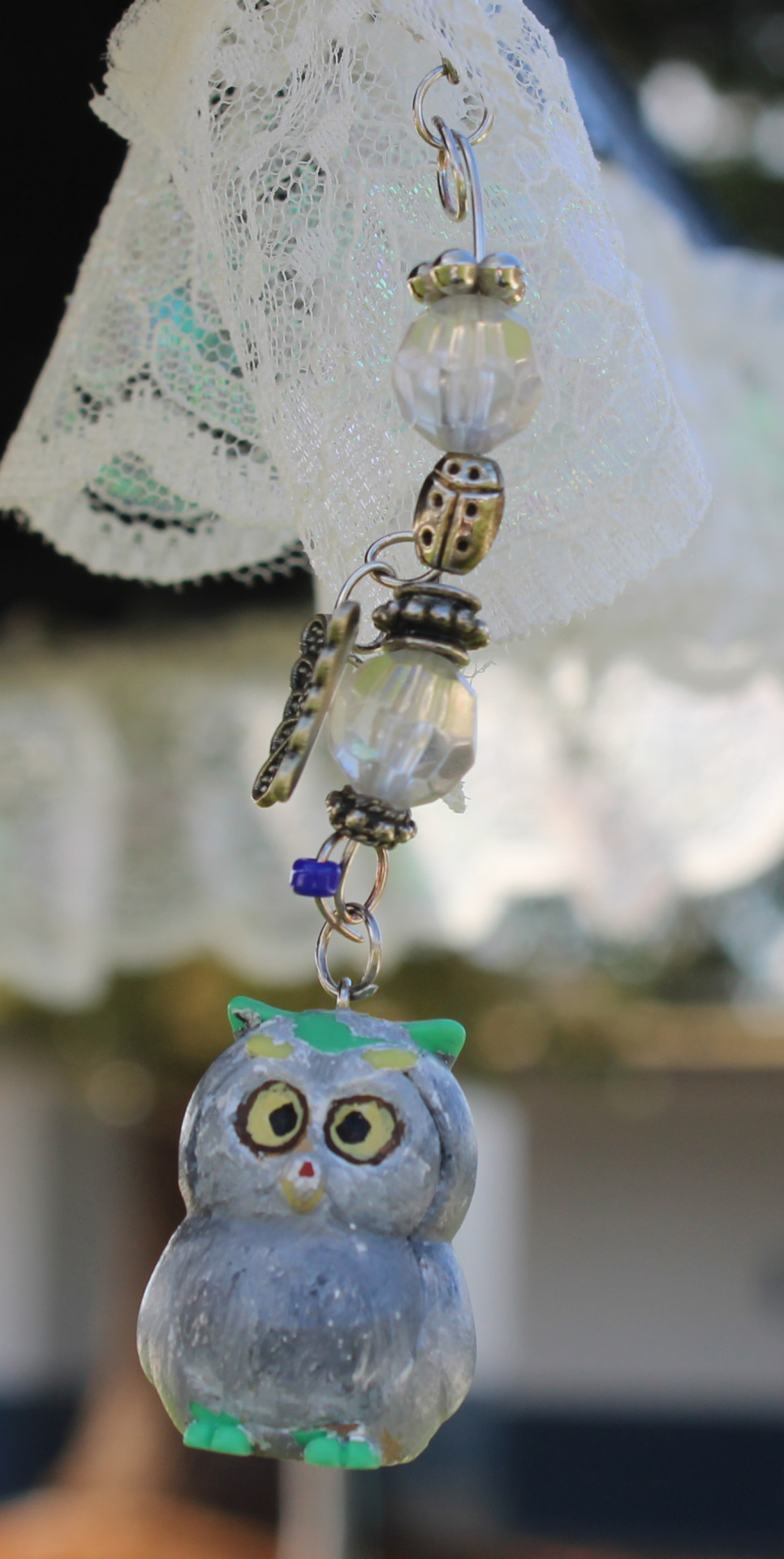
Ok so merle is doing a little worse for wear here. The texture of the owl toy (flea market baybeee) I painted probably isn't best suited to that without some prep work. For Merle, I chose the eastern screech owl because they are small and a little angry but still have the owl angle. His charm is a butterly (thought it does not show up great in this photo), though it WAS an angel before that one got lost somewhere. Oh well, still works with his nature thing!
The Wordless One.

Davenport is so tiny compared to the rest!! I guess it's fitting, but it made him hard to paint. I chose the Atlantic puffin for him, because of their coloring and the fact that they're social migratory seabirds. His charm is a key (lego, yes yet again) because I felt it made sense for his character. I'm not here to stretch the analogy, it writes itself.
The Voidfish

Finally, we have Fisher! Like Barry and the twins, this started as a minifigure of a jellyfish, before I painted it over with some iridescent blueish paint and sparkle varnish, to give it that magical feel. The charm is an abstract metal series of rings, which I felt fit the whole mystical thing the voidfish has going on.
In conclusion, I spent a lot of time on this project, and am extremely proud of the results, however flawed they may be! I am also very glad tumblr changed their image limit lmao<3
#sierra speaks#a sierra original#cosplay#taz balance#taz lup#taz taako#taz cosplay#the adventure zone#the adventure zone balance#the adventure zone cosplay#taz fanart#the adventure zone fanart#the zone cast#idk what other tags to add lol#anyway this was so much fun and ive been waiting to share it for MONTHS!
239 notes
·
View notes
Text
Animal of the Day!
Calliope Hummingbird (Selasphorus calliope)
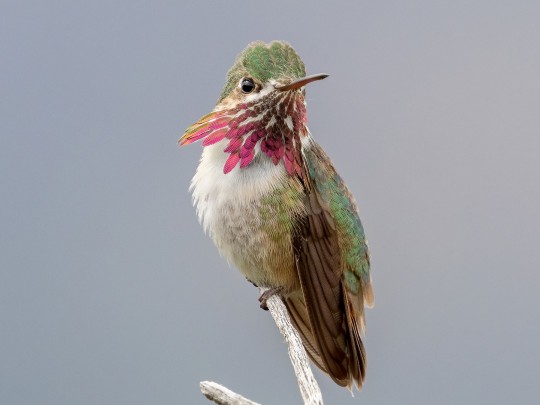
(Photo by Blair Dudeck)
Conservation Status- Least Concern
Habitat- United States; Canada
Size (Weight/Length)- 7.6 cm
Diet- Nectar; Insects
Cool Facts- Being the second smallest bird in the world, the calliope hummingbird makes up for it with their personality. Being almost completely migratory outside of the breeding season, calliope hummingbirds follow the flower blooms from the southern United States to northern Canada and back again. During the mating season, male calliope hummingbirds fiercely defend their stretch of flowers. Their needle sharp beak easily chases away other hummingbirds almost twice their size. To entice a female, the male extends its vibrant pink throat feathers to resemble a flower followed by 20 meter dives towards the ground to show off his flying capabilities.
Rating- 13/10 (Their humming noise comes from their wings, not their beak.)
#Animal of the day#Animals#Birds#Hummingbird#Wednesday#November 23#Calliope hummingbird#biology#science#conservation#the more you know
117 notes
·
View notes
Photo






Recent hummingbirds at Ash Canyon.
From top:
Rufous (Selasphorus rufus). This immature male is displaying the first of his brilliant gold gorget feathers.
Broad-tailed (Selasphorus platycercus) taking an early morning dip.
Anna’s (Calypte anna).
Broad-billed female (Cynanthus latirostris).
Male and female calliope (Selasphorus calliope). We are in the last days of the late-summer stopover in southeastern Arizona, before most of the hummingbirds complete their migration and move on to Central and South America. The calliopes are the most recent visitors to arrive, and I am completely captivated by them. The male is such a standout, with his long, garnet-colored gorget feathers. But the tiny female has won my heart. I rarely see her at nectar feeders; she has a marked preference for flowers. Calliopes are the smallest hummingbirds in the United States, with bodies no bigger than the final joint of my thumb. I love the irony of this tiny bird sharing the name of the Greek muse Calliope, the muse of eloquence and epic poetry, and the most assertive and powerful of the nine muses.
#photographers on tumblr#hummingbirds#birding#Ash Canyon Bird Sanctuary#Southeastern Arizona Bird Observatory#Cochise County#Arizona
143 notes
·
View notes
Text

Wip i might not finish! She's a gynandromorph (half male and half female) and a gryffin! Her bird half is a calliope hummingbird while her feline half is a Canadian lynx. I dont wanna outline all those feathers so I dont really know how to proceed from here.
5 notes
·
View notes
Text

Female Calliope Hummingbird (Selasphorus calliope)
taken in California
status: least concern
The single semi-clear photo I managed of one of the several hummingbirds darting around this tree. It is the smallest bird native to North America. The males have beautiful bright plumage and a pink/purple iridescent throat.
5 notes
·
View notes
Text

Calliope Hummingbird (Selasphorus calliope), male, family Trochilidae, order Apodiformes, UT, USA
Recently removed from the genus Stellula.
photograph by Jack Binch
297 notes
·
View notes
Text
Following last post, there is one kind of bird I know that does not get tubes - and I’m sure part of it is that weighing a hummingbird like that might risk their bill. That and you need to constantly watch the little guys for signs of over stress, where keeping their eyes closed is one warning sign.

This is how you keep a hummingbird safely after capture. For banding, you just kinda wrap it lightly on a stable surface so their wings are immobile, which basically stops a hummingbird from doing much of anything. (Male Lucifer hummingbird pictured)
To weigh them, you make the tiniest, angriest birbrito.


(First picture is a broadbill male, second is a rufous male)
You also feed them immediately after weighing, because of their metabolisms, which works like this and is called the cigar grip;

(Calliope female who we caught three times that day and who was VERY enthusiastic about eating. Weighed in at 2.3 grams which is just a hair under average for a calliope.).
1 note
·
View note
Text
Are Lovebirds Pigeons Too?
Summary: When Stanley becomes disappointed that nobody wants to join his bird-watching club, Richie decides to be a good friend and join him in his endeavors.
Notes: Hey! Hopefully, you enjoy this! I actually researched birds native to Maine for this! Like, reblog. reply, and or send asks if you do!
Ao3: Are Lovebirds Pigeons Too?
Stan loved the losers, he did, but he’d also be lying if he said he didn’t wish he had some other friends who appreciated his some of his other interests more. Sure his baseball team appreciated baseball the way he did, but he doesn’t exactly enjoy spending time with them outside of when he needs to be. He just wished he had somebody to sit and watch birds with every so often. That’s why he started the bird watching club. Yet here he was, at the fifth meeting, alone again. He doesn’t know why he made this stupid club, he was perfectly fine watching birds alone until the idea came to him that maybe he didn’t have to, but, evidently, he does have to.
----
A week later and Stan was preparing himself to once again be let down by the lack of people in his club. You’d think that after a month and a half of the same it would be less disappointing, but it doesn’t. It just becomes more of a reminder that your interests aren’t normal for people your own age. Stan shut his locker and walked towards the school’s exit when he felt a familiar set of hands on his shoulders,
“Stan my man, what’s up? Going to that bird club of yours?”
Stan sighed and stopped walking, turning towards his best friend, “I’d hardly call it a club, Richie. It’s just me there every week.”
Richie was going to make a joke about Stan trying to replace the losers, or even about birds being lame and that’s why nobody wants to join, but he was looking at Stan looking genuinely sad. He never saw his friend like this over being alone. Usually, Stan valued his alone time every so often. Suddenly Richie had an idea.
“You know, Stan, if you want someone to come with you today, I’ll go.”
Stan nearly scoffed at the idea, Richie was his best friend, so he knew better than to think he had any interest in bird watching, “Rich, you really don’t have to. You can just go home and-”
“No, Stan! I want to-I really want to go with you. I think it would be fun.” Richie smiled nervously, Stan noticed that for the first time since they met, Richie looked nervous to be around him, almost the way he used to look at Bowers’s cousin during that summer, but it couldn’t be. Stan was just reading too deeply into it. Richie doesn’t like him.
Stan returned a sheepish smile before replying, “Then what are we waiting for, trashmouth? Let's go.”
Stan and Richie left the school and headed towards the quarry.
“Stan, why are we going to the quarry? We spent the whole fucking summer there. There are no birds.”
Stan shook his head, “Then you haven’t been paying enough attention. Besides, that’s not where we’re going. We’re going to the woods.”
Richie raised his eyebrows, “The woods? Oh, near the kissing bridge? How romantic Stanley.”
Stan’s face felt hot and he knew it was bright red. Usually he’d be unbothered by Richie’s comments, but with the way he was staring at him earlier, and now Stan is holding Richie by the hand, leading him towards the area Richie had never been before, it’s all a bit too much for him, “Shut up, Richie.” Unbeknownst to Stan, Richie was also blushing, struggling to keep his up with his usual trashmouth self. Stan stopped walking and he let go of Richie’s hand, “We’re here.” he said, removing his blanket from his bag and his pair of binoculars. He laid the blanket down before sitting and patting the blanket next to him, signaling for Richie to sit, which he gladly did.
“Ya know Stan, I still don’t see many birds.”
“We just got here. They’ll come. We just have to be quiet and wait.”
The two boys sat together in the comfortable silence they’ve come to enjoy over so many years of friendship. Stan shifted slightly and his hand brushed against Richie’s. Both pretended not to notice the other’s cheeks become a subtle shade of pink, because there’s no way it could be because of the other. Richie was watching Stan and suddenly his face lit up.
“What do you see, Stanny?” Richie asked, and the small bird looked towards them briefly before choosing to ignore them.
“Be quiet,” Stan whispered, pointing to the small brown bird in the tree, “it’s up there.”
“Is that a pigeon?” Richie asked, his voice hardly a whisper.
Stan shook his head, he should’ve known Richie would treat this as a joke, but he told him anyway, “It’s a black-billed cuckoo. Coccyzus erythropthalmus. One of the few cuckoo species that look after their own eggs. They’re omnivorous, mainly eat insects though,”
Stan continued speaking about the bird and Richie intently listened, eyes shifting from the bird and towards Stan. He looked at Stan’s brown eyes and his smile reached them. Stan looked genuinely happy and his passion made Stan look all the more beautiful to Richie. He wanted to kiss him and tell him how beautiful he looked when he was passionate, but he kept quiet, knowing Stan could never reciprocate.
Stan stopped speaking and Richie pointed over to a tree branch directly above them, the two boys laid back, “What about that Stan? Is that a pigeon?”
Stan shook his head, “Richie, it's safe to say we won’t see many pigeons here.”
“But we have, because that’s a pigeon, right?”
Stan shook his head again, this time letting out a soft chuckle, “No. It’s a great crested flycatcher. Myiarchus crinitus. It’s the most widespread member of its genus. It’s almost always in the treetops. It actually doesn’t have sexual dimorphism like most birds do. Males and females generally look the same.”
Richie stared at Stan again, looking at his soft lips and wondering how they’d feel against his own.
“Richie,” Richie was still in his own head when Stan lightly smacked his shoulder, and he became aware of how dark it suddenly was, “Rich. It’s getting dark. We should go home now.”
Richie sat back up and nodded, before standing and helping Stan fold his blanket, “You know Uris, I really enjoyed being here today. Would it be okay if I came with you next week?”
Stan smiled widely, nodding his head. Maybe he didn’t need new friends to bird watch with him. Maybe he just needed Richie. Richie who made him laugh, and who laughs at Stan’s jokes even when he doesn’t understand it. Richie, who he had a huge crush on.
----
Weeks go by and Stan and Richie fell into their comfortable rhythm. Every Monday after school, the pair meet up at Stan’s locker, they leave, and find their favorite tree to sit under. Well, Stan’s favorite tree to sit under, Richie doesn‘t know enough about trees to have a favorite, but if Stan likes that one then there must be a reason why. Every time they see a bird Richie asks “is that a pigeon?”, to which Stan always replies with a whole slew of information about the bird, and slowly Richie begins to understand why Stan loves this so much. Richie compulsively performs for the world to feel seen, but Stan sees him, and he sees more than just “trashmouth”. Stan sees Richie as the smart, funny, loyal friend that he is. It’s easy to forget Richie’s act is just that, an act, but Stan never does. That’s why I love him , Richie thinks to himself.
“Hello? Earth to Richie? You okay?” Eddie asked, waving his hand in front of his face.
Richie shook his head, coming out of his daze, “Huh? Yeah Spaghetti man. Just thinking about your mom.”
The rest of the losers let out a small chuckle, the one they let out whenever Richie makes a “classic Richie” joke.
“Oh very funny, trashmouth. Come up with some new material.”
“Can’t. I have a brand, Eds. Would you ask John Mulaney to stop talking about his wife?” Richie looked at Eddie with a smile that screamed ‘you know I’m right’.
Eddie turned away from his friend, this time addressing the group as a whole, “So like I was saying, Stan, are you still looking for people to join your bird watching club?”
“I mean it’s hardly a club. It’s just Richie and I.” Stan looked at his friend and they exchanged soft smiles.
“S...o do you want us t-to join?” Bill asked, “If we’re all there maybe m-more people would c-come.”
“Strength in numbers,” Bev added.
“If you guys want. Nobody is gonna force you to, but if you think you’d have fun go ahead. Meet us at my locker after 8th period today.”
---
So they did, and Stan led them down towards the quarry, like he did the first time he took Richie, except this time, they didn’t sit down under their usual tree. Instead, opting to walk south a few extra yards before settling down. Per usual Stan and Richie sat next to each other, personal space hardly existing, Bill and Eddie to Stan’s left and Mike, Bev, and Ben to Richie’s right.
“So when do the birds show up?” Mike wondered.
Stan went to reply, but before he could Richie whispered his reply, “Well, sometimes we don’t see any, but it helps to be quiet.”
The rest of their friends looked at the pair quizzically, disbelieving that Richie would find interest in a hobby that involved such quiet, reading their reactions, Stan quietly told the losers that, no, Richie did not, in fact, scare the birds away.
A few moments passed before Ben pointed to Stan and Richie’s usual bird watching tree, “What’s that?” he asked.
“That’s a calliope hummingbird. Selasphorus calliope. It’s named after the Greek muse Calliope. It’s actually late in the season to be seeing one this far north.” Richie told Ben. This time even Stan was surprised at Richie’s answer.
Stan looked up at Richie, looking pleasantly surprised by his friend’s knowledge, “I never told you about them,”
“I know, but I fell in love, so I did some research of my own,” Richie replied, smiling sheepishly and staring directly into Stan’s eyes, trying to say three very important words without actually speaking.
“With bird watching?” Stan asked, his heart beating out of his chest, face red. He was returning Richie’s gaze and, hey Stan hadn’t noticed his hand was on Richie’s, no need to move it though. That would make it a thing , and it’s not a thing .
Richie gulped and his smile went from sincere to playful, as he tried to laugh off what he said, “Of course. Bird watching.”
Ben and Bev exchanged looks, wordlessly saying “Bird watching, my ass” and “We’ll talk later” to each other, respectively before shaking the moment off, returning their eyes to the bird.
“Hey guys, what about that one?” Eddie asked, grabbing the pair’s attention and removing the two from each other's gaze and to the new bird, Stan’s hand lingering a moment longer before slowly removing it from Richie’s own and answering Eddie’s question.
As the sun began to set the losers all head out of the woods and made their separate ways. Ben deciding to take the long way home to talk to Bev about what they noticed earlier.
Bev was the first of the pair to speak, “So, you know we can’t go to the next meeting, right?”
“Of course. I’m sure bird watching is fun, but we were definitely sitting in on their thing . It would be like if everyone else sat around watching us when we show each other new music.”
“Exactly. So how are we going to convince everyone else not to go?”
----
The rest of the week came and went, and it was Monday again. Just as they did the week before everyone had gathered around Stan’s locker.
“Are you guys ready to go bird watching again?” Mike asked his friends, “I had fun last week” he added.
“You know,” Ben said, drawing out the ‘o’ sound of the word, “I wish we could, but don’t you remember we all have, uh…”
“Band practice!” Bev interjected, “Remember?”
“I...don't…” Eddie said, confused by the couple.
Beverley shifted her eyes quickly to Stan and Richie who were quickly becoming suspicious of their friends.
“Oh! Right!” Mike exclaimed, “Band practice! Don’t you remember, Bill?”
“Uh, sure. We all have band practice.” Bill replied, nodding, still confused, but figuring his friends would explain later when they were alone.
“Are you guys okay? I don’t remember ever making a fucking band, let alone agreeing to rehearse on a Monday . Who does that?”
Bev laughed nervously, trying to signal to Eddie to shut up and ask questions later before dragging him by the arm away from Stan and Richie and the rest of their friends following.
“Well that was weird” Stan pointed out.
“I know” Richie stated, “Why weren’t we invited to be in the band?”
---
Stan stopped at their usual tree, grabbing Richie’s arm to signal him to stop walking when he continued. “Oh, we’re sitting here again?”
“Yeah. This is our tree.” He said, sitting down, still holding his friend’s arm as he followed suit sitting down on the ground. Stan inched closer to Richie before putting his head on Richie’s shoulder.
“Long day, buddy?” Stan couldn’t help but feel disappointed by the word ‘buddy’, but outwardly he didn’t show it.
“Yeah.”
Richie took Stan’s hand and gently rubbed his knuckles, just two bros , Richie thought to himself. Just a friend comforting a friend , “What happened?”
Stan sighed, “Nothing really, just usual school stuff.”
“So its a personal thing? You can tell me anything, Stan. You know that. We tell each other everything.”
Stan gulped, looking up in the treetop before noticing a brown bird and pointing up at it, “Look at that.” Stan said, almost a little too loudly, excited to have a distraction from the conversation.
“Is that a pigeon?” Richie asked, as he always did.
“No. Well, actually, they’re in the same family. It’s a mourning dove. Zenaida macroura. It’s actually one of the most widespread birds in North America and it’s a popular game bird.”
For the first time since joining the club, Richie zoned out. Instead just watching Stan speak passionately and smiling at his friend as he watched Stan crane his neck to see the bird, knowing Stan’s neck would hurt later before shrugging it off and saying it was worth it. He kept thinking about how much he admired Stan’s passion for birds, and for everything he loved even if he was alone in that passion. How Stan is always trying to take an interest in the passions of his other friends, because Stan loved to see his friends happy, and how it’s a shame none of them tried to love his interest in birds sooner.
Stan asked Richie a question, and when he didn’t respond Stan lightly tapped his friend’s face, “Pay attention to the bird, ninny. Look at them, not me.”
Richie shifted over a little bit and Stan took his head off the taller boy’s shoulder, “Hey Stan, I have an unrelated question. Doves are a symbol of love, right?”
“Right.”
“And so are lovebirds.”
“Yes.”
“So are lovebirds pigeons too?”
“No. They’re actually a species of parrot. Why?”
“Well, people call couples lovebirds right, and Ben and Bev are a couple.”
“Richie, I don’t understand where you’re going with this.”
“Just, sh. I’m going somewhere with this I promise.”
“Okayy…” Stan said, staring at his friend, becoming more confused as every second passed.
“Well sometimes I look at the way they act, and how we act towards each other, and I think ‘maybe we’re kinda similar’. Basically, what I’m trying to say is-”
Stan interrupted Richie, “I love you too, doofus.”
Richie’s face lit up, feeling a ten-pound weight come off his chest and his smile spreading from ear to ear, “Really?”
“Yes. Really.” Stan said, returning Richie’s wide smile, and it would have gotten wider if that were at all possible as Richie placed his hand gently on Stan’s cheek and he leaned in and placed a kiss on Stan’s lips. It was, for lack of a better term, very them. It was a little awkward for a second before they relaxed and just let everything fall into place. It felt right, like they should’ve done this years ago, back in that summer, even, when Richie was too busy chasing some asshole closet case when he had known who he really wanted was his best friend. When he could’ve had him for years by now. Richie chuckled at the thought and Stan pulled away, his joy quickly turning into anxiety that he had done something wrong, “What’s so funny, Rich?”
“Just that we should’ve done this ages ago.”
Stan’s smile came back, “agreed,” he said before pulling Richie into another kiss.
#stanley uris#richie tozier#stozier#stanley uris x richie tozier#stanley x richie#stan x richie#it chapter one#it chapter two#it stephen king#it 1990#it 2017#it 2019
49 notes
·
View notes
Text
the hummingbirds.
A list of my friends!
Aurora - a little female calliope hummingbird, she visits the most.
June - a scruffier female ruby-throated hummingbird, and my first griffin friend.
Seán - a sleek male green-breasted mango hummingbird, he sleeps on my windowsill.
Mango - a brilliant male ruby-topaz hummingbird, he’s a great protector.
Jet - a soft female black-chinned hummingbird, she’s my newest friend.
Hummingbird
15 notes
·
View notes
Text
Calliope Hummingbird - The Smallest Bird, Range, & Size
New Post has been published on https://www.birdsandblossom.com/calliope-hummingbird/
Calliope Hummingbird - The Smallest Bird, Range, & Size
The Calliope Hummingbird is a beautiful and smallest hummingbird, native to the Canada and United States, during winter season found in Central America. Even with their tiny size, these birds are able to survive cold nights at high altitudes in the northern Rockies Mountains.
Some travel each year from Canada to southern Mexico, in migration they may be unnoticed, often eating at low flowers. They avoid the aggression of larger hummingbirds such as Rufous hummingbirds.
During winter and migration they also occur in lowland brushwood regions, chaparral, deserts and semi-desert areas. The Calliope hummingbirds breed in Meadows Mountains especially Aspen groves near streams, winters mostly in pine-oak woodlands in Mexico.
Calliope Hummingbird Description
They have glossy green on the crown and back with white underparts. The mature Calliope hummingbird male has violet-red streaks on the throat; flanks are green and a dark tail. The Calliope hummingbird beak and tail are quite short.
The females have a pink color on the flanks, dark strips on their throat and a dark tail with white tips. . The young Calliope hummingbird size is 2.8 to 3.9 inches or 7 to 10 cm long, and weighs 2 to 3 grams or 0.071 to 0.106 oz.
Calliope Hummingbird Diet
Mostly feed nectar from a wide variety of tubular and radiant colors flowers of trees, plants, herbs, and epiphytes.
The favorite flowers with the highest sugar content look for and aggressively defend these areas.
The Calliope hummingbird feed on nectar from flowers, using an extendable slender tongue.
During the winter season, when flowering shrubs are not readily available, they may drink sap from cavities made by sapsuckers or take insects on the wings.
They also visit often at native hummingbirds feeders that have sugar water, at feeders, may either hover or perch.
The Calliope hummingbird may also occasionally catch and eat some small insects and spiders.
To catch small insects, may fly out and capture them in midair, or taken from leaves, twigs or spider webs
These are high sources of protein, and mainly required during the breeding season for the good growth of their chicks.
The female can catch about 2,000 insects during breeding season everyday.
These birds prefer foraging nearer to the ground than other hummingbirds.
When defending their breeding areas, they roost on higher alder and willow branches.
Most of the Calliope hummingbird can digest nectar in 25 minutes; and regularly feed five to nine times per hour.
While collecting nectar, they also assist in plant pollination. The Calliope hummingbird prefers plants for pollinating are included the paintbrush, columbine, penstemon, and trumpet gilia.
The Calliope Hummingbird Behavior
The male behaviors an aerial display having a series of diving flights, they make U-shaped dives rising 30 to 100 feet to attract females. The male flies in front of and over the female during courtship, producing a loud call.
Sometimes the male and female goes into midair, turning around each other, but constant at a distance.
Like many hummingbirds, they are very territorial during the breeding season.
Calliope hummingbirds make mechanical twittering and buzzing sounds, both loudly and with their wings. Their vocalizations are softer than some other hummingbirds.
The Calliope Hummingbird Breeding
The breeding territories of Calliope hummingbird are different among open shrub habitats and elevations. The nest typically builds at higher altitudes; and open woodland, Meadows Mountain, alder and willow thickets may help as breeding grounds.
They nest in western North America from southern British Columbia and Alberta south to Colorado and southern California. The male create breeding territory and drives other males away from their areas.
The nest site is normally in a conifer or pine, sometimes in deciduous flowering shrub, usually 6 to 40 feet higher. Occasionally they built nest on bottom of old pine cone. The Calliope hummingbird female construct the nest a dense cup of moss, plant down, spider webs, bark fibers, with the outside camouflaged with chip of lichen.
The Calliope hummingbirds are migrating birds, mostly leaving their breeding grounds before than most hummingbird species. They take advantage of the last summer weeds in the mountains of western North America.
The female are laid two eggs from end of May to early July and incubated for 15 to 16 days. The young are capable of flight about 20 days after hatching.The mother feeds the young, and keeps them warm between feeding short period and at night. The young leave the nest about 18 to 21 days.
#Calliope Hummingbird#Calliope Hummingbird Call#Calliope Hummingbird Female#Calliope Hummingbird Male#Calliope Hummingbird Male And Female#Calliope Hummingbird Range#Calliope Hummingbird Size
0 notes
Text
Calliope Hummingbird - The Smallest Bird, Range, & Size
New Post has been published on https://www.birdsandblossom.com/calliope-hummingbird/
Calliope Hummingbird - The Smallest Bird, Range, & Size
The Calliope Hummingbird is a beautiful and smallest hummingbird, native to the Canada and United States, during winter season found in Central America. Even with their tiny size, these birds are able to survive cold nights at high altitudes in the northern Rockies Mountains.
Some travel each year from Canada to southern Mexico, in migration they may be unnoticed, often eating at low flowers. They avoid the aggression of larger hummingbirds such as Rufous hummingbirds.
During winter and migration they also occur in lowland brushwood regions, chaparral, deserts and semi-desert areas. The Calliope hummingbirds breed in Meadows Mountains especially Aspen groves near streams, winters mostly in pine-oak woodlands in Mexico.
Calliope Hummingbird Description
They have glossy green on the crown and back with white underparts. The mature Calliope hummingbird male has violet-red streaks on the throat; flanks are green and a dark tail. The Calliope hummingbird beak and tail are quite short.
The females have a pink color on the flanks, dark strips on their throat and a dark tail with white tips. . The young Calliope hummingbird size is 2.8 to 3.9 inches or 7 to 10 cm long, and weighs 2 to 3 grams or 0.071 to 0.106 oz.
Calliope Hummingbird Diet
Mostly feed nectar from a wide variety of tubular and radiant colors flowers of trees, plants, herbs, and epiphytes.
The favorite flowers with the highest sugar content look for and aggressively defend these areas.
The Calliope hummingbird feed on nectar from flowers, using an extendable slender tongue.
During the winter season, when flowering shrubs are not readily available, they may drink sap from cavities made by sapsuckers or take insects on the wings.
They also visit often at native hummingbirds feeders that have sugar water, at feeders, may either hover or perch.
The Calliope hummingbird may also occasionally catch and eat some small insects and spiders.
To catch small insects, may fly out and capture them in midair, or taken from leaves, twigs or spider webs
These are high sources of protein, and mainly required during the breeding season for the good growth of their chicks.
The female can catch about 2,000 insects during breeding season everyday.
These birds prefer foraging nearer to the ground than other hummingbirds.
When defending their breeding areas, they roost on higher alder and willow branches.
Most of the Calliope hummingbird can digest nectar in 25 minutes; and regularly feed five to nine times per hour.
While collecting nectar, they also assist in plant pollination. The Calliope hummingbird prefers plants for pollinating are included the paintbrush, columbine, penstemon, and trumpet gilia.
The Calliope Hummingbird Behavior
The male behaviors an aerial display having a series of diving flights, they make U-shaped dives rising 30 to 100 feet to attract females. The male flies in front of and over the female during courtship, producing a loud call.
Sometimes the male and female goes into midair, turning around each other, but constant at a distance.
Like many hummingbirds, they are very territorial during the breeding season.
Calliope hummingbirds make mechanical twittering and buzzing sounds, both loudly and with their wings. Their vocalizations are softer than some other hummingbirds.
The Calliope Hummingbird Breeding
The breeding territories of Calliope hummingbird are different among open shrub habitats and elevations. The nest typically builds at higher altitudes; and open woodland, Meadows Mountain, alder and willow thickets may help as breeding grounds.
They nest in western North America from southern British Columbia and Alberta south to Colorado and southern California. The male create breeding territory and drives other males away from their areas.
The nest site is normally in a conifer or pine, sometimes in deciduous flowering shrub, usually 6 to 40 feet higher. Occasionally they built nest on bottom of old pine cone. The Calliope hummingbird female construct the nest a dense cup of moss, plant down, spider webs, bark fibers, with the outside camouflaged with chip of lichen.
The Calliope hummingbirds are migrating birds, mostly leaving their breeding grounds before than most hummingbird species. They take advantage of the last summer weeds in the mountains of western North America.
The female are laid two eggs from end of May to early July and incubated for 15 to 16 days. The young are capable of flight about 20 days after hatching.The mother feeds the young, and keeps them warm between feeding short period and at night. The young leave the nest about 18 to 21 days.
#Calliope Hummingbird#Calliope Hummingbird Call#Calliope Hummingbird Female#Calliope Hummingbird Male#Calliope Hummingbird Male And Female#Calliope Hummingbird Range#Calliope Hummingbird Size
0 notes
